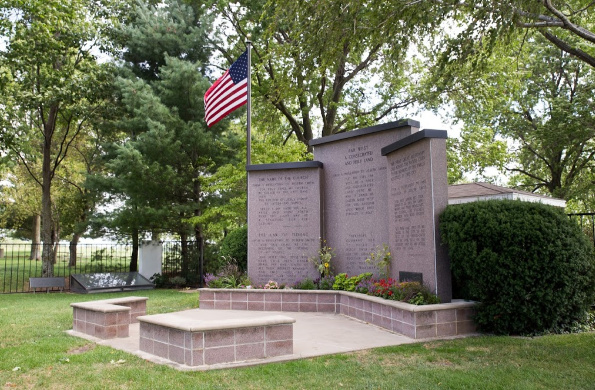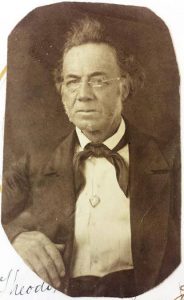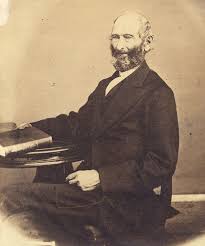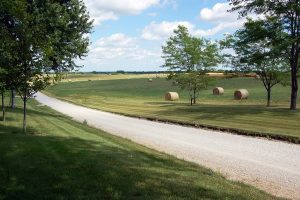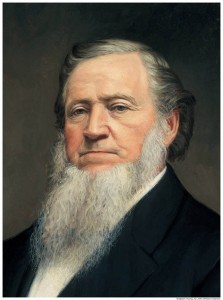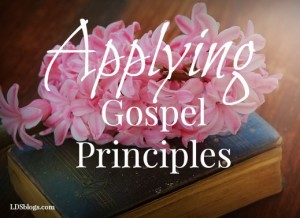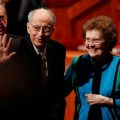Usually, the 24th of July brings to mind my ancestors crossing the plains to the Salt Lake Valley. 117 of my direct ancestors crossed the plains. Some of their journeys began in Norway and Denmark, England and Australia. But most of their treks West began from Nauvoo, Illinois, after their beloved prophet and friend was martyred at Carthage Jail.
Before that westward trek, one ancestor that found himself imprisoned for preaching the Gospel and impoverished at the hands of a mob was Theodore Turley.
When Parley P. Pratt preached the gospel in Canada, he baptized John Taylor and Isaac Russell (among others) who preached the Gospel in the land after Elder Pratt left. They couldn’t find a place to preach so asked my grandpa, local Methodist minister Theodore Turley, if they could preach in his church.
Theodore agreed to their preaching engagement and encouraged his congregation to attend. During the meeting, Theodore recognized “That is the truth and I shall be condemned if I do not accept it.”
He wrote that
“[Isaac Russell] came to me and said he had been warned in a dream that he must come to my house to preach. I received the truth the first time I heard it, and my wife also was baptized on the 1st of March, 1837.”
On March 2, 1837, Theodore Turley was called on a mission to preach the Gospel of Jesus Christ.
Then I was ordained an Elder by Parley P. Pratt, continued preaching until we went to Kirtland and from there to Missouri and remained one year.
Sold my farm for $1400. Started with two wagons and four horses in company with Elder John Snider and family, Joel Terry and family. Arrived in Far West on July 28, 1838. … Distance about 1000 miles traveled by land, desirous of settling my family in peace, far from the noise of war, etc., with the advantages of communion with the people of God.
Unfortunately, the Turleys did not find peace in Far West, Missouri. In October 1838, Governor Boggs issued the extermination order to drive Mormons from the state of Missouri.
The Devil and all his host was determined we should not enjoy it long for he caused the Missourians to maltreat us and unconstitutionally drive us from the state.
In December 1838, Theodore served on the committee of citizens of Caldwell County that drafted a memorial to Congress. Heber C. Kimball ordained him a Seventy and the Council of Seventy began meeting in his home in January 1839.
Extermination Order—Exodus from Missouri
On 26 January 1839, the council appointed Theodore to a committee of seven to ascertain the needs of the poor Saints to expedite their exodus from Missouri. On this errand, Theodore sent communication to the state judges, the Secretary of State to expedite the release of Joseph Smith and his companions from Liberty Jail. The “men appeared friendly and acknowledged that the brethren were illegally imprisoned…but…had no power to do good!”
Heber C. Kimball and Theodore Turley returned immediately to Liberty. Arriving there on the 30th, they went to call on Judge King. He was very angry because they had reported the case to the governor. “I could,” he said, “have done all the business for you properly, if you had come to me; and I would have signed the petition for all except Joe, and he is not fit to live.
They then visited the prison, but were not permitted to enter; all the communication they had with the prisoners took place through the grate of the dungeon. Joseph bid the brethren to be of good cheer, ‘for,’ said he, ‘we shall be delivered; but no arm but God can deliver us now. Tell the brethren to be of good cheer, and get the Saints away as fast as possible.’
Threats on Joseph Smith’s Life
On April 5th, Brothers Kimball and Turley returned to Far West. On that day a company of about fifty men in Daviess County swore that they would never eat or drink again until they had murdered Joe Smith. Their captain, William Bowman, swore, in the presence of Theodore Turley, that he would ‘never eat or drink, after he had seen Joe Smith, until he had murdered him.’
Theodore Turley Defends the Far West Prophecy
Photograph of John Whitmer / via Joseph Smith Papers
Also eight men—Captain Bogart, who was the county judge, Doctor Laffity, John Whitmer, and five others—came to the committee room at Far West and there presented Elder Theodore Turley the paper concerning the revelation of July 8, 1838 to Joseph Smith, that the Twelve were to take their leave on the Temple site at Far West, on April 26th, to go to the Isles of the sea, and then asked him to read it.
Turley said, ‘Gentlemen, I am well acquainted with it.’
They said, ‘Then you, as a rational man, will give up Joseph Smith being a Prophet and an inspired man, now he and the Twelve are scattered all over creation; let them come here, if they dare; if they do, they will be murdered. As that revelation cannot be filled, you will now give up your faith?’
Turley jumped up and said, ‘In the name of God that revelation will be fulfilled.’ They laughed him to scorn. John Whitmer hung down his head.
They said, ‘If they [the Twelve] come, they will get murdered; they dare not come to take their leave here; that is like all the rest of Joe Smith’s d–d prophecies.’ They commenced on Turley and said, ‘You had better do as John Corrill has done; he is going to publish a book called ‘Mormonism Fairly Delineated;’ he is a sensible man, and you had better assist him.’
Turley said, ‘Gentlemen, I presume there are men here who have heard Corrill say that ‘Mormonism’ was true, that Joseph Smith was a Prophet and inspired of God, etc. I now call upon you, John Whitmer: You say Corrill is a moral and good man; do you believe him when he says the Book of Mormon is true, or when it is not true? There are many things published that they say are true, and again turn around and say they are false.’
Whitmer asked, ‘Do you hint at me?’ Turley replied, ‘If the cap fits, you may wear it; all I know is that you have published to the world that an angel did present those plates to Joseph Smith.’
Whitmer replied, ‘I now say, I handled those plates; there were fine engravings on both sides. I handled them; they were shown me by a supernatural power.’ He described how they were hung and accordingly acknowledged all.
Turley then asked him, ‘Why is the translation not now true?’ He said, ‘I could not read it (in the original) and I do not know whether it (i.e., the translation) is true or not.’ Whitmer testified all this in the presence of eight men.
The Saints Evacuate Missouri
Due to threats and malice, the committee sped up the poor Saints’ evacuation.
Far West, Missouri
When the Saints commenced removing from Far West, they shipped as many families and as much goods as possible to Richmond, to go down the Missouri River and up the Mississippi to Quincy, Ill… The exodus throughout was managed with consummate wisdom, and in view of all the difficulties in the way, with less suffering than could have been expected. The distance to the point of the Mississippi River where most of the exiles crossed over to Illinois was over two hundred miles in an easterly direction. The weather was cold and the roads generally muddy and bad. Scores of Saints died from exposure and fatigue on that memorable journey.
The move was not undertaken in a solid body, and seldom in regularly organized companies, but in small squads–two, three, and from that to a dozen teams and upwards traveled together. Not a single family who wished to go was left behind, as the committee appointed to superintend the removal paid particular attention to all the poor, and furnished them with the necessary teams and provisions to perform the journey.
While the Saints were making preparations to move away as fast as possible the mob was continually threatening the lives of the members of the committee and others. Thus, frequently armed bands of mobbers came into Far West and abused men, women and children, stole horses, drove off cattle, and plundered houses of everything that pleased them…
Because of the persecutions, the committee, on the 14th of April, 1839, moved thirty-six families into Tenny’s Grove, about twenty-five miles from Far West, and a few men were appointed to chop wood for them, while Elder Turley was to furnish them with meal and meat until they could be removed to Quincy. The corn was ground at the committee’s horse mill at Far West.
On the morning of the 18th Elder Kimball went into the committee room and told the members of the committee who were present to wind up their affairs and be off or their lives would be taken.
Later in the day a number of mobbers met Elder Kimball on the public square in Far West and asked him if he was a d–d ‘Mormon.’ He replied, ‘I am a “Mormon”‘.
‘Well,’ they said, ‘We’ll blow your brains out, you G–d d–d Mormon,’ and they tried to ride over him with their horses. This took place in the presence of Elias Smith, Theodore Turley and others of the committee.
Almost immediately afterward, twelve men went to Elder Turley’s house with loaded rifles intending to shoot him. They broke seventeen clocks into matchwood, broke tables, chairs and looking-glasses, smashed in the windows, etc., while Bogart, the county judge, looked on and laughed. One mobber by the name of Whitaker threw iron pots at Turley, one of which hit him on the shoulder, at which Whitaker jumped and laughed like a mad man.
The mob shot down cows while the girls were milking them, and threatened to send the committee ‘to hell jumping,’ and ‘put daylight through them.’
The brethren gathered up what they could and left Far West in one hour. The mob stayed until they left, and then plundered $1,000 worth of property which had been left by the more well-to-do Saints to help the poor remove.
One mobber rode up and finding no convenient place to fasten his horse, shot a cow that was standing near, and while the poor animal was yet struggling in death, he cut a strip of her hide from her nose to the tip of her tail, which he tied around a stump and fastened his halter to it.
On the 20th of April 1839, the last of the Saints left Far West. Thus a whole community variously estimated from twelve to fifteen thousand souls, had left, or were about to leave the State of Missouri, where they had experienced so much sorrow, and found a temporary shelter in the State of Illinois, chiefly in Quincy and vicinity and a few in the territory of Iowa on the north.”
Theodore Turley remained there [in Far West] until all the saints were removed and Joseph Smith got out of prison.
Theodore wrote of his own exodus:
“I left in Caldwell a dwelling house and stable, garden, well of water with conveniences, a work shop well fitted up, ten acres of timber land, two town lots. Unrighteously driven from the same, with about 10,000 (ten thousand) souls in company, trusting till God shall redeem us from the injustice of man. In consequence of the extreme forteage of labors of fitting up teams, etc., to convey the poor to the State of Illinois; being appointed one of the committee for that purpose. The journeys to the various prisons; the journeys with Petitions to the Gov. Boggs and to the Supreme Judge of the Courts of the State of Missouri laboring variously for the relief of my brethren and sisters for the space of nearly six months; after the fatigues of war. The particulars of which is impossible to describe. Then journeying with my wife and children 200 miles in a wet time; living in a tent for the space of 13 weeks and never having the privilege of sleeping under a roof for this time.”
April 26, 1839, the Date of the Far West Prophecy
The Church’s second prophet, Brigham Young
By the twenty-sixth of April, the day set for them to take leave of the Saints to start on their mission, nearly all the members of the Church had been driven from Far West. It seemed almost impossible that the prediction could be fulfilled, as the Saints had all been driven out of Missouri, and it would, according to the threats of the mob, be as much as an Apostle’s life was worth to be seen in Far West.
Some of the leading men in the Church thought that in view of the persecutions and scattered condition of the Saints at that time, the Lord would not require the Twelve to fulfill His words to the letter but that, under the circumstances, He would take the will for the deed. The apostates and mobbers rejoiced at what they thought would be the failure of one of the revelations given through the Prophet Joseph; they thought that surely in this instance, at least, his words would be vain.
But this was not the feeling of President Young and those of the Twelve Apostles who were with him. He asked them individually what their feelings were upon the subject. Their desires were, they said, to fulfill the revelation.
He told them that the Lord had spoken, and it was their duty to obey, and leave the event in his hands, and he would protect them. Consequently, Brigham Young, Orson Pratt, John Taylor, Wilford Woodruff, George A. Smith and Alpheus Cutler left Quincy for Far West to fulfill the revelation. They met John E. Page, who was an Apostle at the time, on the road, and told him they wanted him to go to Far West with them, which he did.”
Just before reaching Far West (at Tenney’s Grove) Brigham Young and his traveling companions met Brothers Smith, Turley and Clark of the committee who had been left there to attend to the removal of the poor Saints but had been driven from town.
They told the Apostles that members of the mob had come into Far West and tantalized them on the subject of the revelation, saying that it was one of Joseph Smith’s revelations which could not be fulfilled, as the Twelve Apostles were scattered to the four winds; and they threatened them severely if they were found in Far West the next day.
In the face of these threats, Elders Smith, Clark, and Turley, turned around and accompanied the Apostles and the other brethren to Far West, having faith that the Lord would protect them.
Early on the morning of the 26th of April–the day mentioned in the revelation–a conference was held, 31 persons were cut off from the Church, and the Apostles and Saints proceeded to the building spot of the Lord’s house. Elder Cutler, the master workman of the house, then recommenced laying the foundation, agreeable to revelation, by rolling up a large stone near the southeast corner.
Seven of the Twelve Apostles were present. They then sang ‘Adam-ondi-Ahman;’ after which they took leave of eighteen Saints, agreeable to the revelation. The conference was then adjourned.
Theodore Testifies to Isaac Russell
To read more of Delisa’s articles, click here.
As the Saints were passing away from the meeting, Theodore Turley said to Elders Page and Woodruff, ‘Stop a bit, while I bid Isaac Russell good-bye,’ and knocking at his door called Brother Russell, whose wife answered, ‘Come in; it is Brother Turley.’
Russell replied, ‘It is not; he left here two weeks ago.’ He appeared quite alarmed; but on finding it was Turley, asked him to sit down, but he replied, ‘I cannot; I shall lose my company.’
‘Who is your company?’ inquired Russell.
‘The Twelve.’
‘The Twelve?’
‘Yes, don’t you know that this is the 26th, and the day the Twelve were to take leave of their friends on the foundation of the Lord’s house, to go to the islands of the sea? The revelation is now fulfilled, and I am going with them.’
Russell was speechless and Turley bid him farewell. Thus was that revelation fulfilled, concerning which the enemies said: If all the other revelations of Joseph Smith were fulfilled, that one should not be, as it had place and date to it.
“The Lord had spoken, and it was their duty to obey.” In the face of violence and death, Theodore Turley did his duty.
Lead Image: Far West Temple site via Facebook.
About Delisa Hargrove
I am a member of The Church of Jesus Christ of Latter-day Saints. I have moved 64 times and have not tired of experiencing this beautiful earth! I love the people, languages, histories/anthropologies, & especially religious cultures of the world. My life long passion is the study & searching out of religious symbolism, specifically related to ancient & modern temples. My husband Anthony and I love our bulldog Stig, adventures, traveling, movies, motorcycling, and time with friends and family.

